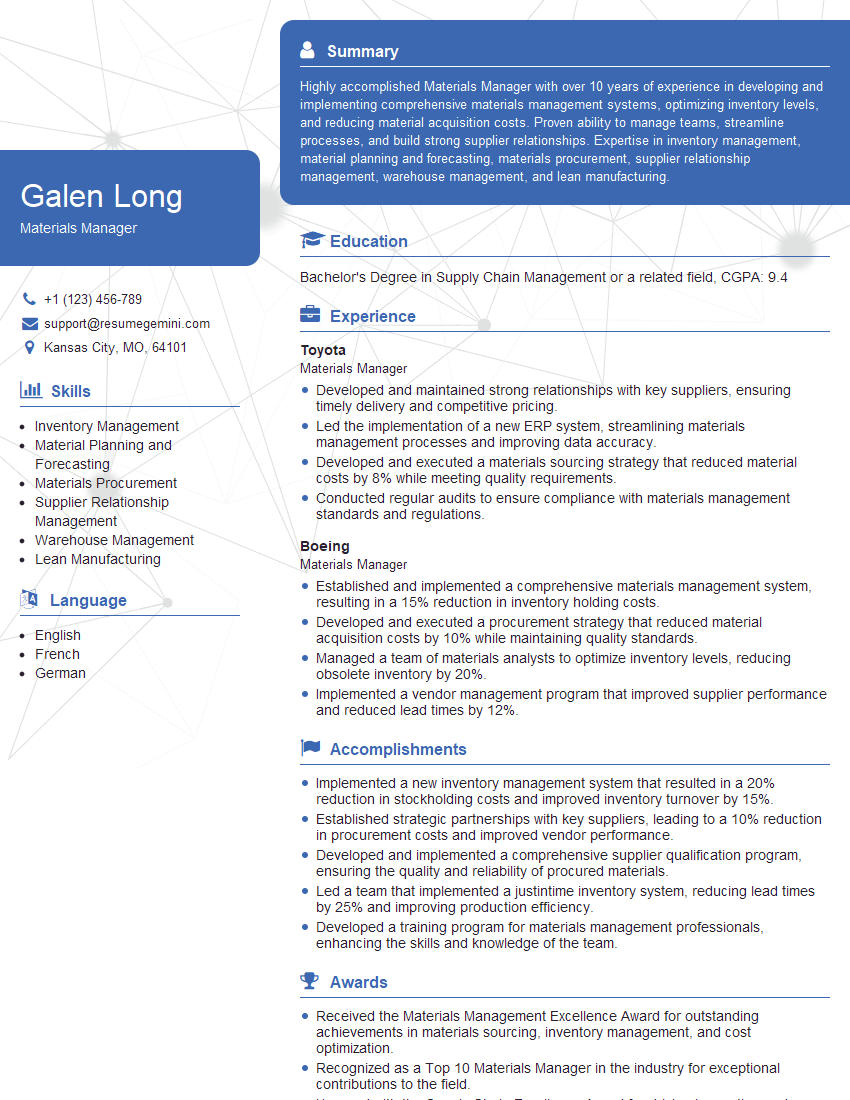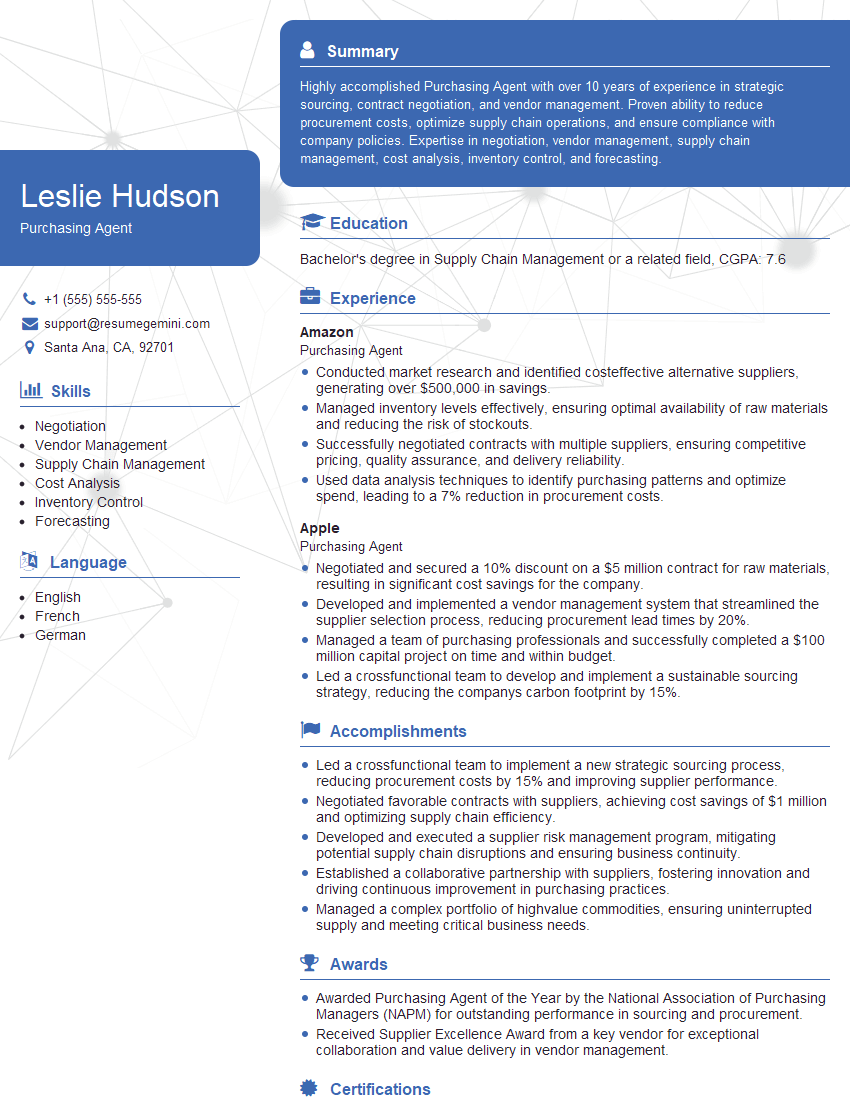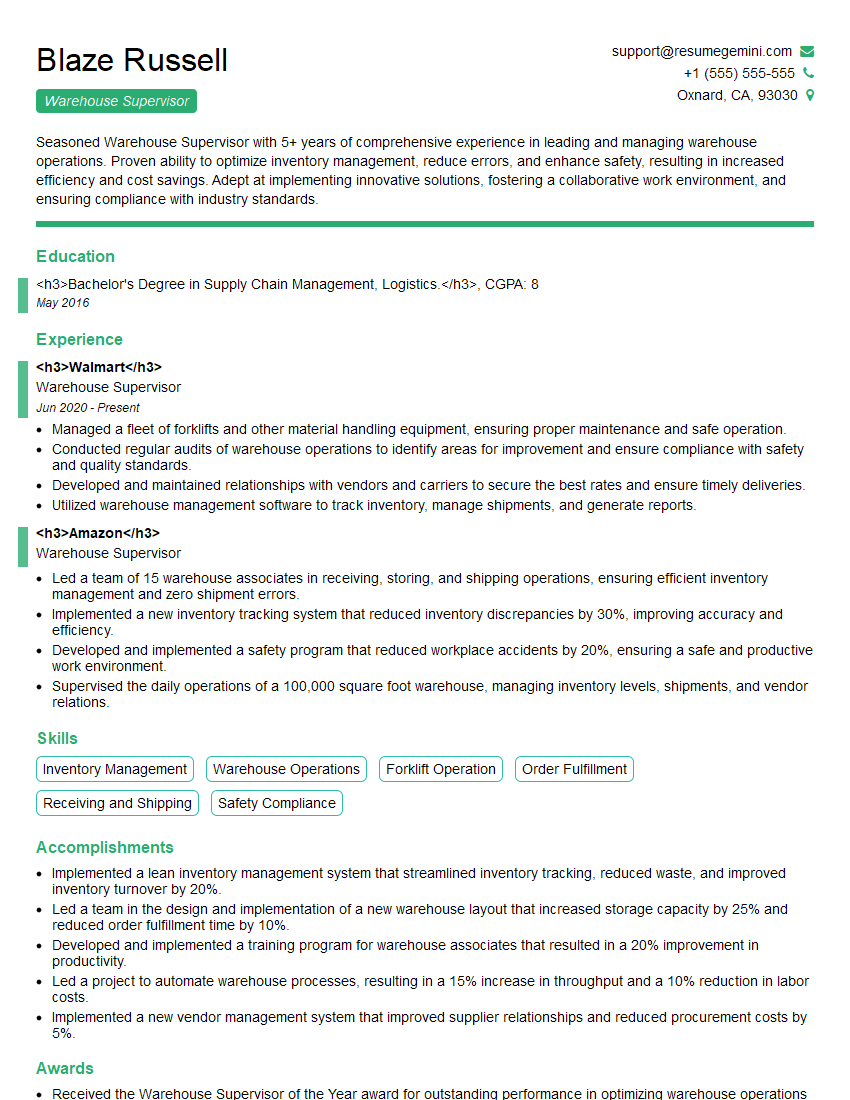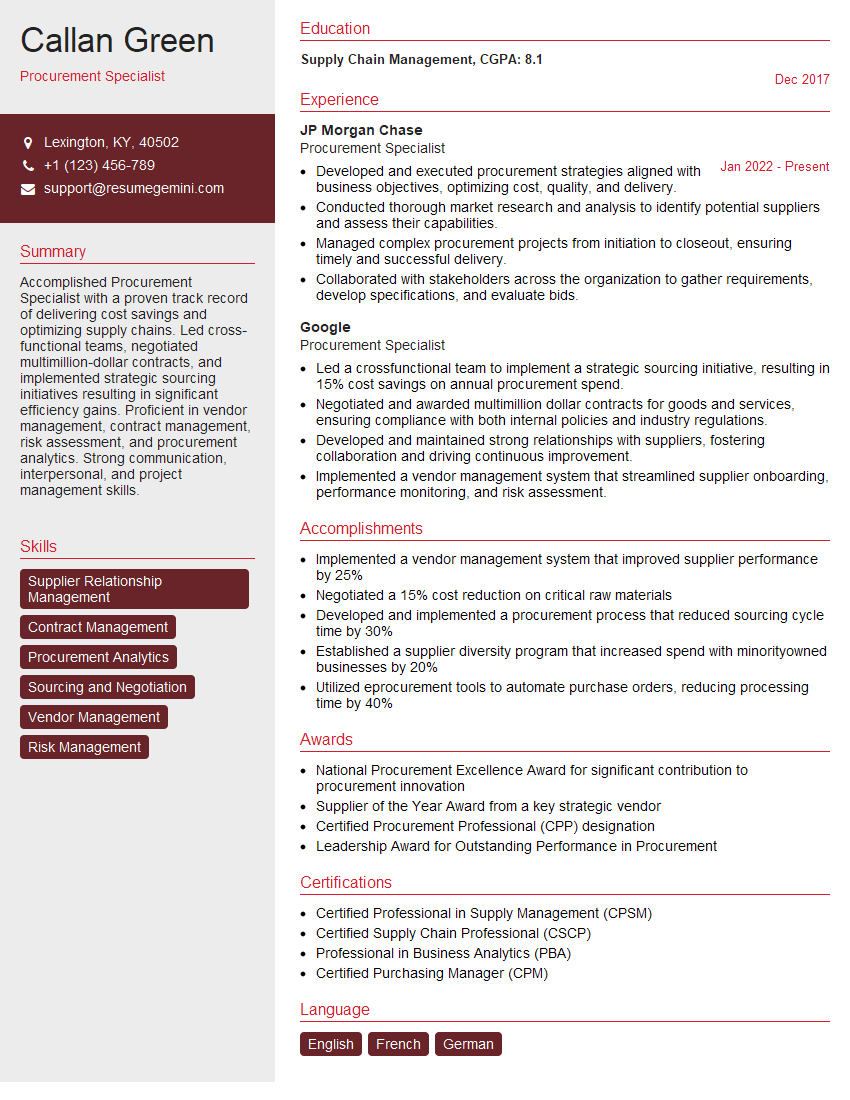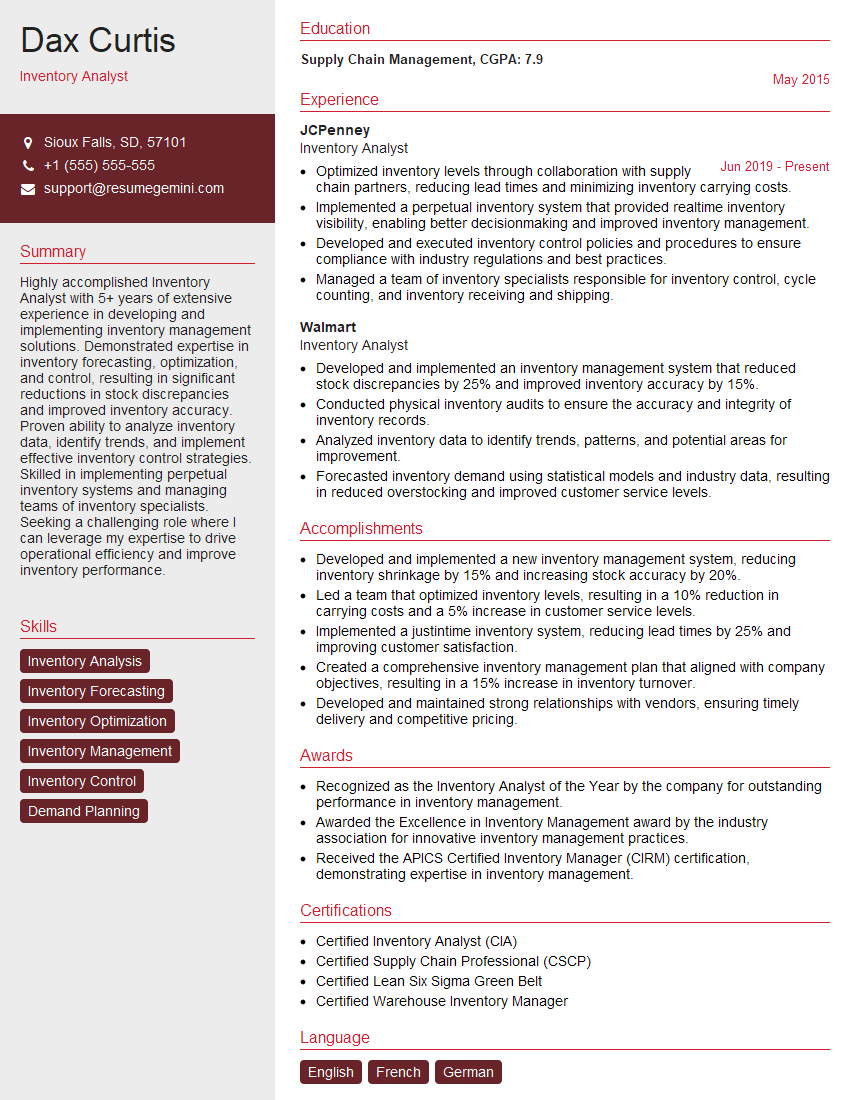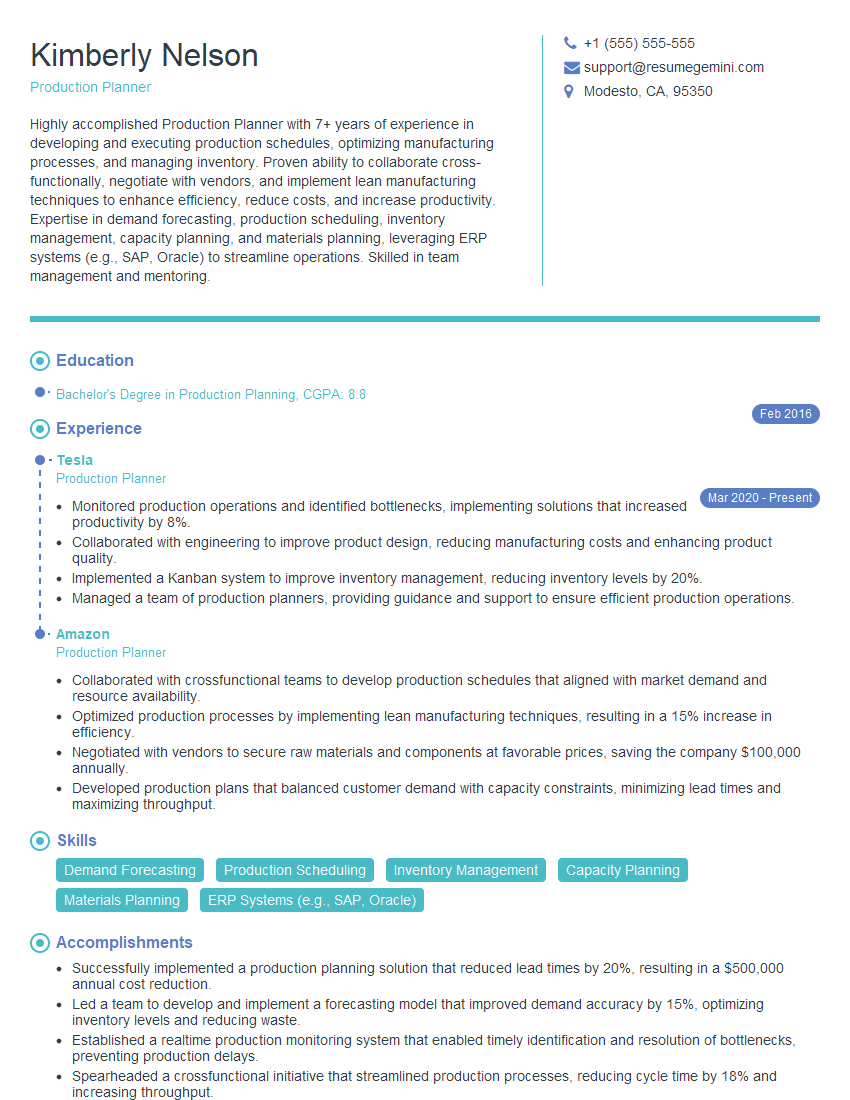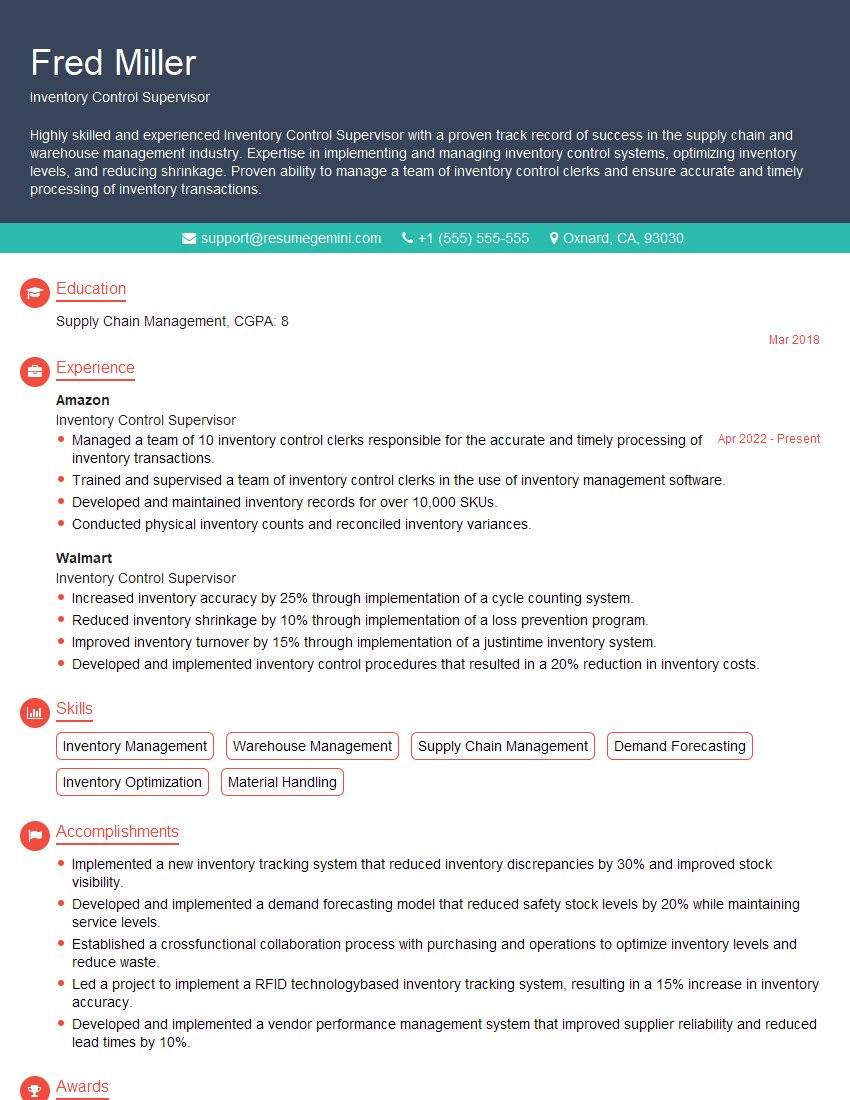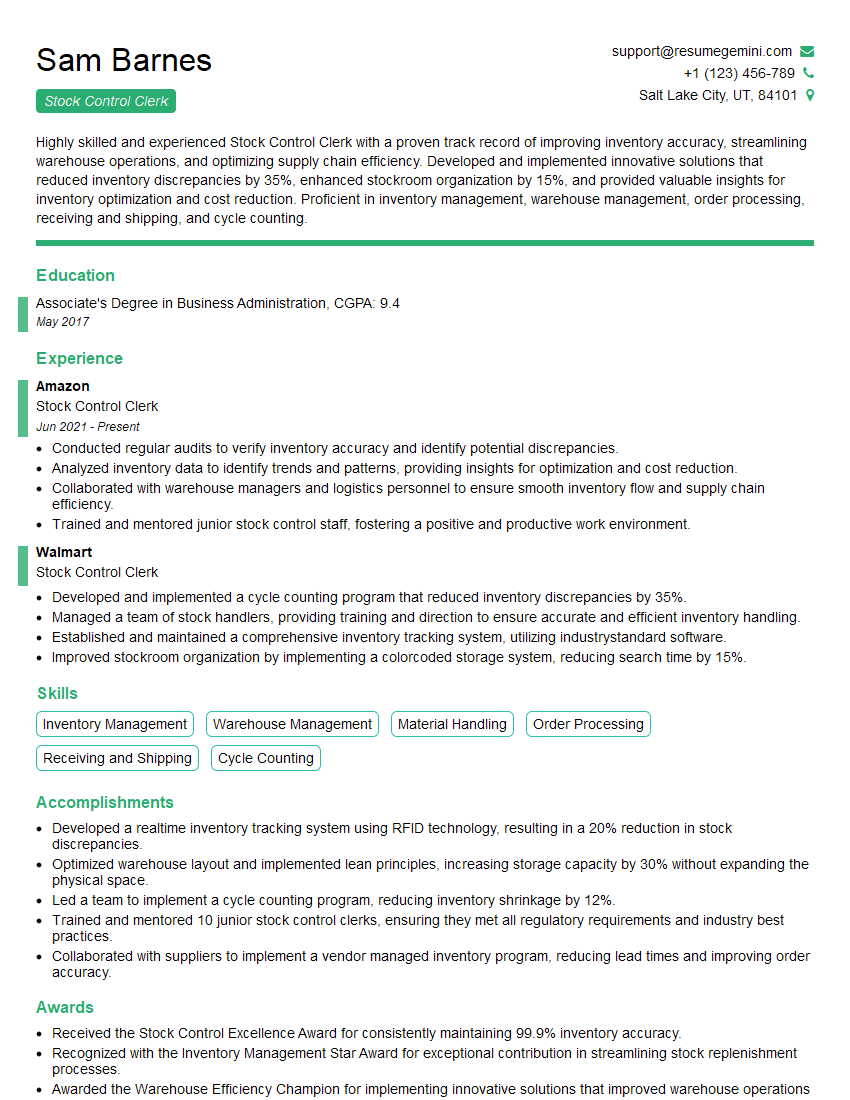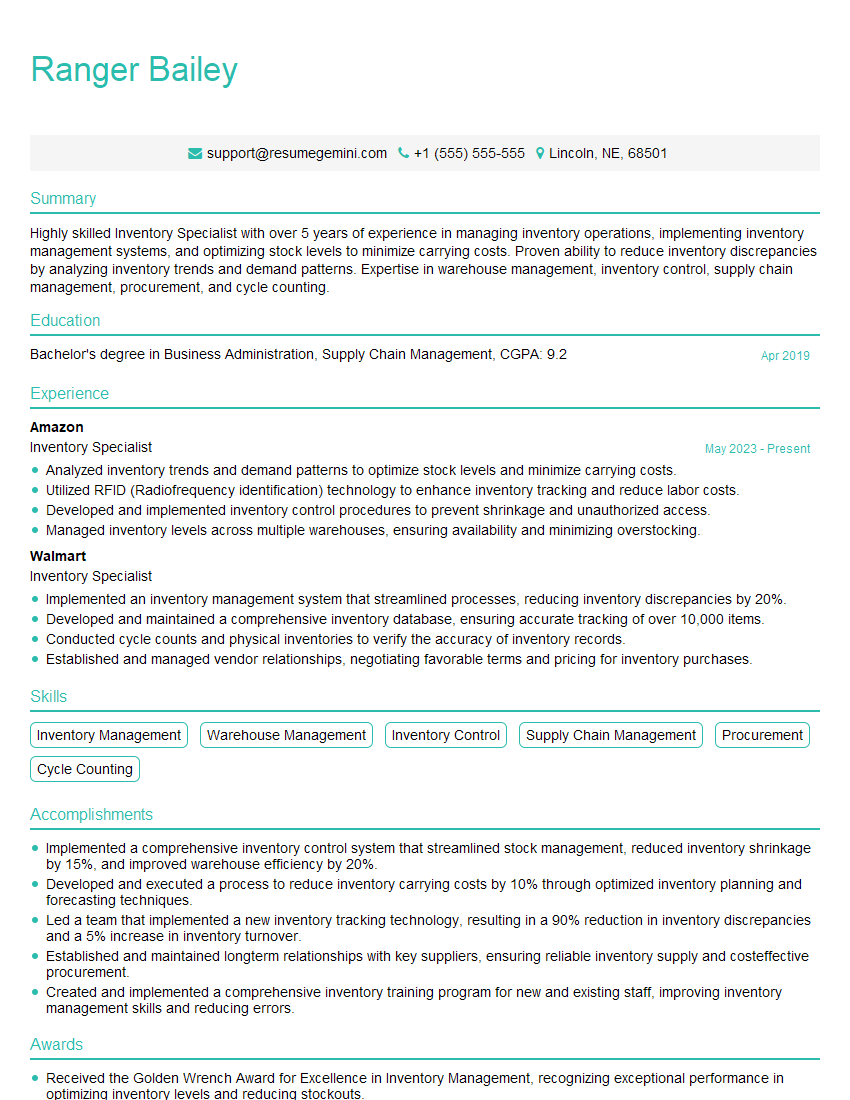Unlock your full potential by mastering the most common Monitoring and maintaining inventory levels interview questions. This blog offers a deep dive into the critical topics, ensuring you’re not only prepared to answer but to excel. With these insights, you’ll approach your interview with clarity and confidence.
Questions Asked in Monitoring and maintaining inventory levels Interview
Q 1. Explain the different inventory valuation methods (FIFO, LIFO, weighted average).
Inventory valuation methods determine the cost of goods sold and the value of ending inventory. Three common methods are FIFO (First-In, First-Out), LIFO (Last-In, First-Out), and Weighted Average Cost.
FIFO (First-In, First-Out): This method assumes that the oldest inventory items are sold first. Imagine a bakery: the first croissants baked are the first ones sold. This results in the cost of goods sold reflecting older prices, and the ending inventory reflecting more recent costs.
Example: If you purchased 10 units at $10 and later 10 units at $12, and sold 15 units, using FIFO, your cost of goods sold would be (10 * $10) + (5 * $12) = $160. Your ending inventory would be 5 units valued at $12 each.
LIFO (Last-In, First-Out): This method assumes the newest inventory items are sold first. Using the same bakery example, this would mean the most recently baked croissants are sold first. This results in the cost of goods sold reflecting more recent prices, and ending inventory reflecting older costs. Note that LIFO is not permitted under IFRS (International Financial Reporting Standards).
Example: Using the same scenario, under LIFO, your cost of goods sold would be (10 * $12) + (5 * $10) = $170. Your ending inventory would be 5 units valued at $10 each.
Weighted Average Cost: This method calculates a weighted average cost for all inventory items. This provides a smoother approach compared to FIFO and LIFO and is less sensitive to price fluctuations. The weighted average cost is calculated by dividing the total cost of goods available for sale by the total number of units available for sale.
Example: Using the same scenario, the weighted average cost is (($10 * 10) + ($12 * 10)) / 20 = $11 per unit. The cost of goods sold would be 15 * $11 = $165 and ending inventory value would be 5 * $11 = $55.
The choice of method impacts financial statements, so selecting the most appropriate method aligns with the company’s accounting policies and industry best practices.
Q 2. How do you calculate safety stock?
Safety stock acts as a buffer against unexpected demand or supply chain disruptions. Calculating it involves considering several factors:
Lead time demand: This is the average demand during the time it takes to replenish your inventory (lead time). For example, if your average daily demand is 10 units and your lead time is 5 days, your lead time demand is 50 units.
Demand variability: This represents the fluctuation in demand. A higher variability necessitates a larger safety stock. This is often expressed as standard deviation.
Service level: This is the desired probability of meeting demand during lead time. A higher service level requires a greater safety stock.
A common formula is: Safety Stock = Z * σLT
Where:
- Z is the Z-score corresponding to your desired service level (e.g., Z = 1.64 for a 95% service level).
- σLT is the standard deviation of lead time demand.
For instance, if your lead time demand is 50 units, its standard deviation is 10 units, and you want a 95% service level (Z = 1.64), your safety stock would be 1.64 * 10 = 16.4 units, rounded up to 17 units.
Q 3. What are the key performance indicators (KPIs) you use to monitor inventory levels?
Key performance indicators (KPIs) for monitoring inventory levels provide insights into inventory efficiency and effectiveness. Crucial KPIs include:
Inventory turnover ratio: This measures how efficiently inventory is used. A higher ratio indicates faster sales and potentially less risk of obsolescence. Calculated as Cost of Goods Sold / Average Inventory.
Days of inventory on hand (DIOH): This shows how many days of sales are covered by current inventory levels. Calculated as (Average Inventory / Cost of Goods Sold) * 365.
Stockout rate: The percentage of times an item is out of stock when demanded. A lower rate is desirable.
Inventory holding cost: The total cost of storing and maintaining inventory (storage, insurance, obsolescence, etc.). Lower costs are better.
Fill rate: The percentage of customer orders fulfilled from available inventory. Higher fill rates are better for customer satisfaction.
By tracking these KPIs, businesses can identify areas for improvement and optimize their inventory management strategies.
Q 4. Describe your experience with inventory management software.
I have extensive experience with various inventory management software, including ERP systems (such as SAP and Oracle), and dedicated inventory management platforms. My experience encompasses:
Data entry and management: Efficiently inputting and updating inventory data, ensuring accuracy and completeness.
Demand forecasting: Utilizing software capabilities for demand forecasting to optimize inventory levels.
Reporting and analysis: Generating reports on key inventory metrics and analyzing data to identify trends and areas for improvement.
Integration with other systems: Integrating inventory management software with other systems, such as accounting and sales, for seamless data flow.
Cycle counting and audits: Using software to schedule and manage cycle counting processes to identify and rectify discrepancies.
In my previous role, we implemented a new inventory management system that improved order accuracy by 15% and reduced inventory holding costs by 10% through improved forecasting accuracy.
Q 5. How do you handle inventory discrepancies?
Inventory discrepancies—differences between recorded inventory and physical inventory—require a systematic approach to resolve. My process involves:
Identify the discrepancy: Conduct a thorough physical inventory count and compare it to the system’s recorded quantities.
Investigate the cause: Determine the root cause of the discrepancy. This could involve issues like data entry errors, theft, damage, or inaccurate tracking.
Document the findings: Meticulously document the discrepancy, its cause, and the steps taken to correct it.
Implement corrective actions: Adjust inventory records, address process flaws, implement improved tracking methods (e.g., barcoding, RFID), and strengthen security measures as needed.
Reconcile records: Ensure the inventory records accurately reflect the physical count after corrective actions.
Regular cycle counting minimizes the impact of discrepancies by identifying smaller discrepancies before they escalate.
Q 6. How do you prevent stockouts?
Preventing stockouts requires a proactive and multi-faceted approach:
Accurate demand forecasting: Use historical sales data, market trends, and seasonal factors to predict future demand accurately.
Effective inventory management system: Utilize software that provides real-time visibility into inventory levels and alerts for low stock.
Robust supplier relationships: Maintain strong relationships with reliable suppliers who can deliver inventory quickly and consistently.
Safety stock planning: Maintain appropriate safety stock levels to cover unexpected fluctuations in demand or lead times.
Regular inventory reviews: Conduct routine inventory reviews to analyze stock levels, identify slow-moving items, and adjust purchasing strategies.
Early warning systems: Establish systems that alert you to potential stockouts before they occur, allowing for timely corrective actions.
By combining these strategies, businesses can minimize the risk of stockouts, ensuring customer satisfaction and minimizing lost sales opportunities.
Q 7. What are the costs associated with holding excess inventory?
Holding excess inventory is costly, and these costs are often overlooked. They include:
Storage costs: Rent, utilities, and maintenance of warehouse space.
Insurance costs: Premiums to insure the inventory against loss or damage.
Obsolescence costs: The loss of value of inventory due to technological advancements, changing customer preferences, or expiry dates (e.g., perishable goods).
Capital costs: The cost of tying up capital in unsold inventory. Money invested in inventory could be used elsewhere.
Handling and management costs: The cost of receiving, storing, tracking, and managing the excess inventory.
Potential for spoilage or damage: The risk of items deteriorating or becoming damaged while in storage.
These costs can significantly impact profitability. Effective inventory management aims to minimize excess inventory by optimizing ordering quantities and forecasting accuracy.
Q 8. How do you manage obsolete or slow-moving inventory?
Managing obsolete or slow-moving inventory is crucial for maintaining profitability and efficiency. It involves a multi-pronged approach focusing on identification, mitigation, and liquidation. First, I’d use ABC analysis to categorize inventory based on value and velocity. High-value, slow-moving items (Class A) require immediate attention. I’d analyze sales trends, market changes, and potential obsolescence factors (technological advancements, shifting consumer preferences). For example, if a specific model of phone is no longer popular, it falls into this category.
Mitigation strategies include marking down prices to stimulate sales, bundling with faster-moving items, or exploring alternative sales channels like online marketplaces or liquidators. For truly obsolete items, I’d consider donating them to charity for tax benefits or recycling them responsibly. Regular inventory reviews, coupled with accurate forecasting, are essential to prevent the accumulation of obsolete stock in the first place.
For instance, at my previous role, we identified a line of outdated computer parts. By strategically reducing prices and promoting them as ‘clearance items,’ we successfully moved most of the stock, minimizing losses and freeing up valuable warehouse space. Ultimately, proactive management of slow-moving inventory is about balancing risk mitigation with the potential for recovering some value.
Q 9. Explain your experience with cycle counting.
Cycle counting is a crucial part of maintaining inventory accuracy. Instead of a large, disruptive annual inventory count, cycle counting involves regularly counting smaller portions of inventory. This approach minimizes disruption to daily operations and allows for faster identification of discrepancies. I usually implement a system where different sections of the warehouse are counted on a rotating schedule, assigning specific teams or individuals responsibility for a particular area.
The frequency of counting depends on the item’s value and velocity; high-value, fast-moving items are counted more frequently. I utilize barcode scanners or RFID technology to streamline the process and ensure accuracy. Any discrepancies found are immediately investigated, with root causes analyzed and corrective actions implemented. This might involve retraining staff, improving inventory tracking systems, or addressing issues with receiving or shipping.
In my previous role, we implemented a cycle counting system which reduced our inventory discrepancies by 40% within six months. This not only improved inventory accuracy but also freed up staff time previously dedicated to large-scale annual inventory counts, allowing them to focus on other important tasks.
Q 10. Describe your experience with demand forecasting.
Demand forecasting is crucial for effective inventory management. It involves predicting future customer demand to optimize stock levels and prevent stockouts or excess inventory. I’ve employed various forecasting techniques, including moving averages, exponential smoothing, and more sophisticated statistical models such as ARIMA. The choice of technique depends on the data available and the product’s demand patterns.
For example, simple moving averages work well for products with stable demand, while exponential smoothing is more effective for products with trending demand. More complex models, which can account for seasonality and other factors, can provide more accurate long-term forecasts. It’s crucial to consider external factors like economic conditions, marketing campaigns, and seasonality when building a forecast. Regularly reviewing and adjusting forecasts based on actual sales data is essential to maintain accuracy.
In a previous project, I used exponential smoothing to predict demand for a seasonal product. By incorporating historical sales data and adjusting for anticipated marketing campaigns, we were able to minimize excess inventory while avoiding stockouts during peak season, leading to a significant improvement in profitability.
Q 11. How do you optimize inventory levels to meet customer demand?
Optimizing inventory levels to meet customer demand requires a balanced approach. It’s about minimizing storage costs and preventing obsolescence while ensuring sufficient stock to meet customer needs and avoid stockouts. This involves employing several key strategies:
- Demand Forecasting: As discussed earlier, accurate forecasting is the foundation.
- Safety Stock: Maintaining a safety stock buffer to account for unexpected demand spikes or supply chain disruptions. The level of safety stock should be carefully calculated based on factors like lead time and demand variability.
- Lead Time Management: Minimizing lead time (the time it takes to receive new inventory) can significantly reduce the need for large safety stock levels.
- Inventory Turnover Ratio: Regularly monitoring the inventory turnover ratio helps identify slow-moving items and allows for adjustments to ordering strategies.
For example, implementing a just-in-time (JIT) inventory system can drastically reduce storage costs by receiving inventory only when needed, but it requires a highly efficient supply chain and accurate demand forecasting. Finding the right balance between these factors is key to optimization.
Q 12. What are some common inventory management challenges, and how have you addressed them?
Common inventory management challenges include inaccurate data, inefficient tracking systems, theft or loss, demand forecasting errors, and slow-moving or obsolete inventory. I’ve addressed these issues using a variety of methods. Inaccurate data was addressed by implementing rigorous cycle counting procedures and improving data entry protocols. Inefficient tracking was solved by adopting a new inventory management system (IMS), using barcode scanners and RFID. Theft and loss were minimized by enhancing security measures, like improved access controls and CCTV. Demand forecasting errors were reduced by using more sophisticated forecasting techniques and regularly reviewing the accuracy of our predictions. Finally, slow-moving inventory was managed through price reductions, promotions and alternative sales channels.
For example, in one instance, we discovered significant data inaccuracies due to manual data entry. By implementing a barcode scanning system, we eliminated human errors, improved data accuracy and increased efficiency. Addressing these challenges systematically through process improvements, technological upgrades, and data analysis leads to more efficient and profitable inventory management.
Q 13. Explain your experience with different inventory tracking systems.
My experience encompasses various inventory tracking systems, ranging from simple spreadsheet-based systems to sophisticated enterprise resource planning (ERP) systems. I’m proficient in using systems like SAP, Oracle, and NetSuite, as well as various cloud-based inventory management solutions. Each system offers different functionalities and benefits depending on the scale and complexity of the business. Spreadsheet-based systems are suitable for small businesses with limited inventory, while ERP systems are better suited for large enterprises with complex inventory needs.
I’ve also worked with barcode scanning and RFID systems for real-time inventory tracking and management. RFID provides more granular tracking capabilities, which is particularly beneficial for high-value items or in environments requiring more precise inventory control. The selection of the appropriate system depends on factors like budget, business needs, and the size and complexity of the inventory.
In a previous role, we migrated from a spreadsheet-based system to a cloud-based IMS. This change significantly improved efficiency by automating data entry, providing real-time visibility into inventory levels, and enhancing reporting capabilities.
Q 14. How do you ensure inventory data accuracy?
Ensuring inventory data accuracy is paramount for efficient inventory management. It involves a combination of technological solutions, procedural improvements, and rigorous quality control. Here’s how I approach it:
- Regular Cycle Counting: As mentioned before, this minimizes discrepancies by frequently counting small portions of inventory.
- Barcode/RFID Technology: Automated data capture reduces manual errors and speeds up the counting process.
- Data Validation and Reconciliation: Regularly compare inventory data from different sources to identify and correct discrepancies.
- Staff Training: Proper training on inventory management procedures and the use of technology ensures consistent data accuracy.
- Inventory Management System (IMS): Implementing a robust IMS streamlines data entry, tracking, and reporting, significantly reducing errors.
- Regular Audits: Conducting periodic audits of inventory processes to identify areas for improvement.
For example, by implementing a system of regular data reconciliation between the physical inventory count and the IMS, we successfully reduced discrepancies and improved data integrity significantly.
Q 15. How do you collaborate with other departments to manage inventory effectively?
Effective inventory management isn’t a solo act; it requires seamless collaboration across departments. I approach this by establishing clear communication channels and shared goals. For example, I work closely with the procurement team to forecast demand accurately and ensure timely replenishment. Regular meetings are key – we discuss upcoming projects, sales forecasts, and potential supply chain disruptions. This proactive approach prevents stockouts and minimizes excess inventory. With the sales team, I share real-time inventory data to manage customer expectations and avoid promising unavailable items. Finally, with the production team (if applicable), I coordinate production schedules to match demand, minimizing waste and maximizing efficiency. Think of it as a well-orchestrated symphony; each section (department) plays its part to create a harmonious whole (optimal inventory levels).
Career Expert Tips:
- Ace those interviews! Prepare effectively by reviewing the Top 50 Most Common Interview Questions on ResumeGemini.
- Navigate your job search with confidence! Explore a wide range of Career Tips on ResumeGemini. Learn about common challenges and recommendations to overcome them.
- Craft the perfect resume! Master the Art of Resume Writing with ResumeGemini’s guide. Showcase your unique qualifications and achievements effectively.
- Don’t miss out on holiday savings! Build your dream resume with ResumeGemini’s ATS optimized templates.
Q 16. Describe your experience with implementing or improving inventory management processes.
In my previous role, our inventory management system was outdated and inefficient, leading to frequent stockouts and excess inventory. I spearheaded an initiative to implement a new inventory management software (IMS). This involved a multi-stage process: First, I analyzed our current processes, identifying bottlenecks and areas for improvement. Second, I selected a suitable IMS, considering factors like scalability, integration capabilities, and user-friendliness. Third, I oversaw the implementation process, training staff on the new system and ensuring a smooth transition. Post-implementation, I monitored key metrics like inventory turnover rate and carrying costs to measure the effectiveness of the new system. The result? A 20% reduction in carrying costs and a 15% decrease in stockouts within six months. This wasn’t just about adopting new technology; it was about fundamentally changing our approach to inventory management, making it more data-driven and efficient.
Q 17. How do you prioritize inventory tasks?
Prioritizing inventory tasks requires a strategic approach. I utilize a combination of methods, including the urgency/importance matrix (Eisenhower Matrix). High-urgency, high-importance tasks, such as addressing imminent stockouts of critical items, take immediate precedence. High-importance, low-urgency tasks might include planning for seasonal demand or implementing process improvements. Low-importance tasks are often delegated or scheduled for later. I also consider factors like item demand, lead times, and potential impact on sales or production when prioritizing tasks. For example, prioritizing replenishment of a fast-moving item with a long lead time is crucial to avoid stockouts.
Q 18. How do you handle urgent inventory requests?
Handling urgent inventory requests demands a quick and decisive response. My approach involves immediately assessing the request’s validity and impact. I verify the request’s legitimacy and check available stock. If the item is in stock, I prioritize its immediate fulfillment, coordinating with the warehouse team for quick dispatch. If the item is out of stock, I explore alternative solutions, such as sourcing from an alternate supplier or offering a substitute product. Open communication with the requester is crucial, keeping them updated every step of the way. Transparency builds trust and manages expectations effectively. In the case of recurring urgent requests, I investigate the root cause and implement preventative measures – perhaps adjusting safety stock levels or refining forecasting models.
Q 19. How do you use data analysis to improve inventory management?
Data analysis is the cornerstone of effective inventory management. I leverage various analytical techniques to gain actionable insights. For instance, I use ABC analysis to classify inventory items based on their value and consumption rate, enabling focused attention on high-value items. Demand forecasting using time series analysis helps predict future demand and optimize ordering quantities. Inventory turnover rate analysis helps identify slow-moving items and allows us to adjust purchasing strategies accordingly. I utilize data visualization tools (like dashboards) to communicate findings effectively to stakeholders. By analyzing this data, I can optimize stock levels, minimize waste, and ultimately improve profitability.
Q 20. Explain your experience with physical inventory counts.
Physical inventory counts are essential for ensuring accuracy and validating our inventory records. I have extensive experience in planning and executing these counts, using various methods such as cycle counting (regular counts of smaller sections) and full inventory counts (periodic counts of the entire inventory). Before the count, I ensure that the warehouse is organized, clear labelling is in place, and the counting team is well-trained. During the count, we use barcode scanners to improve efficiency and accuracy. After the count, we reconcile the physical count with our system records, identifying and investigating any discrepancies. Regular physical counts help maintain data integrity, improve forecasting accuracy, and identify areas for process improvement. They are a vital part of maintaining a robust inventory management system.
Q 21. What are your experience with ABC analysis in inventory management?
ABC analysis is a crucial inventory management technique that categorizes items based on their value and consumption. ‘A’ items are high-value, high-consumption items that require close monitoring and tight control. ‘B’ items are moderate in both value and consumption, and ‘C’ items are low-value, high-volume items requiring less stringent management. I use ABC analysis to allocate resources effectively – spending more time managing ‘A’ items (e.g., frequent stock checks, tighter ordering processes) and less time managing ‘C’ items. This ensures that we focus our efforts on the items that have the biggest impact on our bottom line. For instance, prioritizing accurate forecasting for ‘A’ items prevents stockouts of high-value, high-demand products, directly impacting revenue. It’s all about strategic allocation of resources based on the Pareto principle (80/20 rule).
Q 22. Describe a time you had to deal with a significant inventory shortage.
During my time at Acme Corp, we experienced a significant shortage of our flagship product, the ‘Widget X5000,’ due to an unforeseen delay in raw material delivery from our primary supplier. This shortage led to lost sales and impacted customer satisfaction. To address this, I immediately initiated a three-pronged approach:
- Emergency Sourcing: I contacted secondary suppliers to secure alternative sources for the critical raw materials. This involved negotiating expedited delivery and potentially higher costs, but it was vital to resume production as soon as possible.
- Production Prioritization: We prioritized the production of Widget X5000, temporarily halting production of less critical items. This reallocated resources and allowed us to ramp up production of the short-supplied product.
- Communication & Transparency: I worked closely with the sales and customer service teams to inform customers about the delay and manage expectations. This proactive communication minimized negative impact on customer relationships.
The situation highlighted the importance of robust supply chain management and having contingency plans in place to mitigate such risks in the future. We ultimately recovered from the shortage within three weeks, thanks to the swift actions taken and collaborative efforts across teams.
Q 23. How do you maintain accurate records of inventory movements?
Maintaining accurate inventory records is crucial for effective inventory management. I utilize a combination of methods to ensure data integrity. This includes:
- Real-time Inventory Tracking System: We use a sophisticated software system that integrates with our warehouse management system (WMS) and point-of-sale (POS) system, providing real-time visibility into inventory levels, location, and movement. This system automatically updates records whenever a product is received, shipped, or moved within the warehouse.
- Regular Cycle Counting: We perform regular cycle counts, which involves physically verifying the quantity of a subset of inventory items at frequent intervals. This helps identify discrepancies early on, before they escalate into significant issues. The data from cycle counting is then reconciled against the system records.
- Barcode/RFID Scanning: Barcode and RFID technologies are used to automatically track inventory movements throughout the entire supply chain, reducing manual errors and improving accuracy. These technologies are seamlessly integrated with our inventory management system.
- Reconciliation Procedures: At the end of each day or week, we reconcile the physical counts with the system’s records to identify any discrepancies. Investigation of any differences helps prevent repeated errors. This includes identifying potential issues like system glitches or human error.
This multi-layered approach ensures that our inventory records are as accurate and reliable as possible.
Q 24. Explain your experience with inventory reporting and analysis.
My experience with inventory reporting and analysis is extensive. I regularly generate and analyze reports that provide insights into various aspects of our inventory performance. These include:
- Inventory Turnover Rate: This metric helps assess how efficiently we are managing inventory by calculating the number of times inventory is sold and replaced over a period.
- Carrying Costs: I analyze the costs associated with holding inventory, including storage, insurance, and obsolescence. This analysis helps optimize inventory levels to minimize these costs.
- Stockout Rates: Tracking stockout rates allows us to identify which items are prone to shortages, highlighting areas where we need to improve forecasting and procurement processes.
- Demand Forecasting: I use historical sales data and other relevant factors (seasonal trends, economic indicators) to create demand forecasts, ensuring we have the right inventory levels at the right time.
These analyses are crucial for making data-driven decisions regarding purchasing, production planning, and pricing strategies. I utilize various data visualization tools to present these findings clearly and effectively to stakeholders.
Q 25. How do you stay up-to-date on best practices in inventory management?
Staying updated on best practices in inventory management requires a multifaceted approach. I regularly engage in the following activities:
- Industry Publications and Journals: I subscribe to industry publications and journals, such as the Journal of Business Logistics, to stay informed about the latest trends, technologies, and best practices.
- Conferences and Workshops: I attend industry conferences and workshops to learn from experts and network with professionals in the field. This provides invaluable opportunities for learning and knowledge sharing.
- Online Courses and Webinars: Online learning platforms offer a wealth of resources on inventory management. I regularly take advantage of these resources to enhance my skills and knowledge.
- Professional Organizations: I’m a member of professional organizations related to supply chain management and logistics, which provide access to resources, training, and networking opportunities.
By actively seeking out new information and engaging with the industry, I ensure my skills and knowledge remain current and relevant.
Q 26. How do you handle returns and damaged goods?
Handling returns and damaged goods is a critical aspect of inventory management. Our process involves:
- Inspection and Classification: Returned or damaged goods are thoroughly inspected to determine their condition and the reason for return. They are then classified as either returnable, repairable, or scrap.
- Quality Control: Returnable items are inspected for quality before being returned to inventory. Repairable items undergo repairs and refurbishment. Scrap items are disposed of according to proper environmental regulations.
- Inventory Adjustment: The inventory management system is updated to reflect the changes in inventory levels resulting from returns and damage. This ensures that our records remain accurate.
- Root Cause Analysis: We perform root cause analysis of damaged goods to identify potential issues in the handling, storage, or transportation processes. This analysis helps us implement corrective actions to prevent future occurrences.
This systematic approach ensures that we minimize losses associated with returns and damaged goods and maintain the accuracy of our inventory records.
Q 27. What is your experience with vendor managed inventory (VMI)?
Vendor Managed Inventory (VMI) is a collaborative approach where a supplier manages the inventory levels of its products at a customer’s location. I have experience implementing and managing VMI programs. The key benefits are:
- Reduced Inventory Costs: The supplier is responsible for optimizing inventory levels, reducing the customer’s carrying costs.
- Improved Inventory Accuracy: The supplier manages inventory replenishment, minimizing discrepancies between physical inventory and records.
- Enhanced Supply Chain Efficiency: VMI streamlines the ordering and replenishment processes, reducing lead times and improving overall efficiency.
However, successful VMI requires strong collaboration, trust, and data sharing between the supplier and the customer. It’s essential to have clearly defined service level agreements (SLAs) and regular performance monitoring to ensure the program meets both parties’ objectives. In my previous role, we implemented VMI with our key supplier for raw materials, resulting in a 15% reduction in inventory carrying costs and a 10% improvement in order fulfillment time.
Q 28. How would you improve the efficiency of our current inventory management system?
To improve the efficiency of your current inventory management system, I would focus on several key areas:
- Automation: Automate as many tasks as possible, including order processing, inventory tracking, and reporting. This can significantly reduce manual effort and improve accuracy.
- Data Analytics: Implement robust data analytics capabilities to identify trends, patterns, and anomalies in inventory data. This allows for proactive identification and mitigation of potential problems.
- Integration: Ensure that the inventory management system is seamlessly integrated with other business systems, such as ERP, CRM, and WMS. This reduces data silos and improves data flow across the organization.
- User Training and Adoption: Invest in comprehensive training for users to ensure they are proficient in using the system effectively. High user adoption is crucial for success.
- Regular System Review and Updates: Conduct regular reviews of the system to identify areas for improvement and ensure that it remains aligned with business needs. Regular updates keep the system performing optimally.
By focusing on these areas, you can significantly improve the efficiency, accuracy, and overall effectiveness of your inventory management system.
Key Topics to Learn for Monitoring and Maintaining Inventory Levels Interview
- Inventory Control Methods: Understanding different inventory management techniques like FIFO, LIFO, and weighted average cost methods. This includes the practical application of choosing the right method for different business scenarios and its impact on profitability and financial reporting.
- Demand Forecasting & Planning: Learn how to accurately predict future demand based on historical data, sales trends, and market analysis. This involves using forecasting techniques and understanding their limitations in practical scenarios like seasonal fluctuations or unexpected events.
- Inventory Accuracy & Cycle Counting: Mastering techniques for maintaining accurate inventory records. This includes understanding the importance of regular cycle counting, identifying discrepancies, and implementing corrective actions to minimize stock-outs and overstocking.
- Inventory Software & Systems: Familiarize yourself with common inventory management software and systems (ERP, WMS). Understand their functionalities, data input processes, and reporting capabilities. Practical application includes describing experiences with different systems and your ability to troubleshoot common issues.
- Optimizing Inventory Levels: Explore strategies for balancing inventory costs (holding costs, ordering costs, stock-out costs) to achieve optimal stock levels. This includes understanding the Economic Order Quantity (EOQ) concept and its practical application in various contexts.
- Inventory Turnover & Analysis: Understand how to calculate and interpret key inventory metrics like inventory turnover ratio, days of inventory on hand, and gross profit margin. This includes applying this knowledge to identify areas for improvement and make data-driven decisions.
- Problem-Solving & Decision-Making: Be prepared to discuss scenarios involving inventory discrepancies, stock-outs, or overstocking. Demonstrate your ability to analyze the situation, identify root causes, and propose effective solutions.
Next Steps
Mastering inventory monitoring and maintenance is crucial for career advancement in supply chain, logistics, and operations management. It demonstrates your analytical skills, problem-solving abilities, and understanding of crucial business processes. To significantly enhance your job prospects, focus on creating an ATS-friendly resume that highlights your relevant skills and experience. ResumeGemini is a trusted resource to help you build a professional and impactful resume. Examples of resumes tailored to Monitoring and maintaining inventory levels are available to guide your process.
Explore more articles
Users Rating of Our Blogs
Share Your Experience
We value your feedback! Please rate our content and share your thoughts (optional).
What Readers Say About Our Blog
This was kind of a unique content I found around the specialized skills. Very helpful questions and good detailed answers.
Very Helpful blog, thank you Interviewgemini team.


